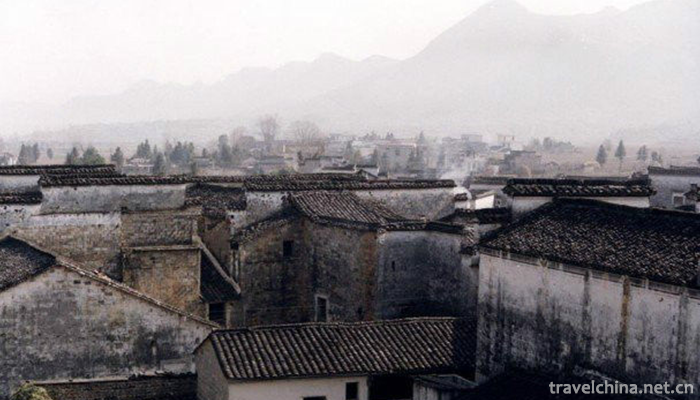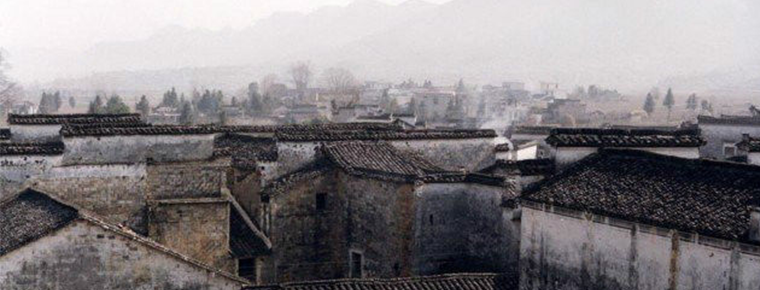The Construction Skills of Hui School Traditional Dwellings
The Construction Skills of Hui School Traditional Dwellings
The construction techniques of Hui traditional dwellings are the traditional wood structure construction techniques with rich local characteristics. The legend of woodworking techniques is written between lines and ink.
As a wonderful flower of Chinese traditional residential architecture, "Hui-style architecture" is a relic of Hui merchant culture.
On June 7, 2008, the construction techniques of Hui-style traditional dwellings were approved by the State Council and listed in the second batch of national intangible cultural heritage list.
Architectural history
Cultural style
Huizhou area was originally inhabited by ancient Yue people. Because of the humid climate in the mountainous areas of southern Anhui Province, in order to prevent jaundice, the ancient Yue people's dwelling style was mainly "dry fence" architecture. After the Han and Wei Dynasties, in order to avoid the war, many large-scale immigration of the Central Plains scholars not only changed the population and structure of Huizhou, but also brought advanced Central Plains culture.
The construction techniques of Hui-style traditional dwellings are a wonderful flower of Chinese traditional dwelling buildings. They are praised for their precise and meticulous village layout, compact and fine architectural pattern, unified and distinct architectural style, profound cultural background, rich and varied architectural decoration, exquisite and superb construction techniques, and can be regarded as the typical representative of Chinese traditional dwelling buildings. Businessmen generally take pains to do things, buy land and build houses economically and economically, thus resulting in a small scale of construction, small patio, no Hall of the final effect. But they are rich, knowledgeable and have a certain appreciation ability, so they will spare no money to engage in brick carving, wood carving decoration, because they know that this is not only a realistic living space effect.
Honor
In June 2008, the construction techniques of Hui traditional dwellings were selected into the second batch of intangible cultural heritage list.
In 2010, as a sub-project of "Chinese traditional wooden structure construction technology", Huizhou traditional architectural construction technology was included in the UNESCO list of representative works of intangible cultural heritage of human beings.
Architectural features
The main combination methods of wood as main building materials, tenon and mortise as wood components, and the building construction technology system of modular system as scale design and processing and production means. This traditional building skill is handed down from generation to generation in the form of "words and deeds" between teachers and apprentices. It has lasted for 7000 years and spread to Japan, Korea and other East Asian countries. It is the representative of ancient Oriental architectural technology. Huizhou traditional architectural construction technology is a treasure of folk architecture art that has been formed gradually by local people in the construction practice for more than 2000 years. It has high academic and practical value. Among them, powder wall, Daiwa, Horsehead wall, brick, wood and stone carving, as well as stacked courtyards, high ridge eaves, winding corridors, pavilions and pavilions constitute a single tree. A School of Hui style architecture keynote. The gables of "Hui-style architecture" are like a banner of calligraphy and painting and a screen, so they are commonly called "screen walls". A rough look, but the real difference is that a horse head like a leap of ambition, a screen like stretching has a long history.
Inheritance of Intangible Heritage
The Ministry of Culture announced the fourth batch of representative successors of national intangible cultural heritage projects, Hu Gongmin was selected.


-
1.Longkou Nanshan Scenic Area
Nanshan tourist scenic spot is located in the beautiful scenery of Lu Shan in Longkou City, Yantai City, Shandong province. The scenic spots of Nanshan Temple
Time 2018-12-08 -
2.Wuhan Haichang Polar Ocean World
Wuhan Haichang Polar Ocean Park is the first Ocean Park constructed by Haichang Group in central China. It is the fifth large-scale theme park covering the concept of polar and ocean
Time 2019-02-24 -
3.ancient game of kicking a ball
Cuju, also known as "Biju", "Cuju", "Cuju", "Cuyun", "Cuyun", "building a ball" and "kicking a round", has the meaning of "Cu
Time 2019-04-22 -
4.Firing Techniques of Liling Unglazed Colorful Porcelain
The firing technology of Liling Unglazed Five-color Porcelain, the local traditional firing technology of Liling Unglazed Five-color Porcelain in Hunan Province, is one of the national intangible cult
Time 2019-05-13 -
5.Legend of Camel Spring
Camel Spring is a provincial key cultural relic protection unit and a patriotic education base. Located in Jiezi Township Unity Village, with convenient transportation and direct access to tertiary oi
Time 2019-05-15 -
6.Legend of Kirin
The legend of Kirin is mainly spread in Jiaxiang County of Shandong Province and its surrounding areas. Kirin is an auspicious God and animal in ancient legends. Ancient books say
Time 2019-06-10 -
7.Qin an Xiaoqu
Qin'an Xiaoqu, also known as the old tune of Qin'an, is one of the national intangible cultural heritages. It is an ancient traditional folk art variety formed and mainly popular in Qin'an and other c
Time 2019-06-10 -
8.Shuixiang Opera
Shuixiang opera is a traditional folk cultural activity in Shaoxing, Zhejiang Province. Waterfront theatres are mostly built on rivers in front of temples such as land temples, so they are called &quo
Time 2019-06-16 -
9.Ulger
Uliger, which means "storytelling" in Mongolian, is commonly known as "Mongolian Shushu", "Mongolian Shushu" and "Mongolian Qinshu". It is a form of music art t
Time 2019-06-29 -
10.Yi Kezhi
Yi Kezhi is a popular oral literature of poetry style among the Yi people. It is the cultural accumulation formed by the Yi people in their long-term production and life, and has a very long history.
Time 2019-07-12 -
11.Panzhihuas primary industry
In 2018, the total output value of agriculture, forestry, animal husbandry and fishery in Panzhihua was 7.027 billion yuan, an increase of 4.2%. Among them, agricultural output value was 4.434 billion yuan, an increase of 5.2%; forestry output value was 108 million yuan, an increase
Time 2020-12-14 -
12.History of Nanchong
In the Northern Song Dynasty (960-1127), there were three states in the territory, which governed 13 counties, such as Nanchong (prefecture), Xichong and Xiangru, which were subordinate to Chengdu Fulu.
Time 2020-12-17